The national flag of Iraq is a powerful emblem, reflecting the nation's complex history, its Arab identity, and its aspirations. It's a symbol that has undergone several transformations, each reflecting significant political shifts and societal changes within the country. The current flag, adopted in 2008, retains the pan-Arab colors while incorporating a key Islamic inscription, representing a blend of Arab nationalism and religious conviction.
Design and Dimensions
The flag of Iraq features three equal horizontal stripes of red, white, and black. The red stripe is at the top, the white stripe is in the middle, and the black stripe is at the bottom. This classic tri-color arrangement is characteristic of many flags in the Arab world, signifying a shared heritage and common historical struggles.
Prominently displayed in the center of the white stripe, in green Kufic script, is the phrase "Allahu Akbar" (God is the greatest). This religious inscription is a defining feature of the current Iraqi flag, distinguishing it from earlier iterations.
While specific official dimensions can vary, the most common and widely recognized proportions for the Iraqi flag are 2:3 (height to width), providing a standard rectangular shape.
Symbolism of the Colors and Elements
Each color and element on the Iraqi flag carries deep symbolic weight, reflecting the nation's past, its present, and its hopes for the future within the broader context of Arab and Islamic identity:
-
Red Stripe: The top red stripe symbolizes bloodshed, sacrifice, and the bravery of those who fought for Iraq's independence and freedom. It's a color that evokes the many struggles and revolutions in the nation's history, representing the courage and determination of the Iraqi people in the face of adversity. Historically, red has also been associated with the Hashemite dynasty, which played a role in Arab nationalism.
-
White Stripe: The middle white stripe signifies peace, purity, and generosity. It represents the aspiration for a tranquil and prosperous future, free from conflict. White is often associated with the generosity and noble intentions of the Arab people, as well as the purity of their hearts. It embodies the hope for unity, reconciliation, and a new beginning for the nation.
-
Black Stripe: The bottom black stripe represents oppression, the dark periods of history, and triumph over enemies. It acknowledges the difficult times and injustices endured by the Iraqi people, but also their resilience and ultimate victory. Historically, black has also been associated with the Abbasid Caliphate, a significant period in Islamic history centered in Baghdad.
-
"Allahu Akbar" (God is the greatest): The green inscription "Allahu Akbar" in Kufic script across the white stripe is a powerful religious and revolutionary motto. Its inclusion firmly places the flag within the Islamic tradition. In this specific context, the phrase was added during the Gulf War era under Saddam Hussein's regime, but it has been retained and is widely accepted as a general expression of Islamic faith and national resolve. The green color of the inscription is traditionally associated with Islam, symbolizing hope, peace, and prosperity, and it's also the color of the banner of the Prophet Muhammad. Kufic script is one of the oldest forms of Arabic calligraphy, lending a sense of historical depth and authenticity to the religious motto.
History of Creation and Adoption
The flag of Iraq has undergone more changes than almost any other national flag, reflecting the country's turbulent political landscape since its establishment as a modern state.
-
Under Ottoman Rule (until 1920): Before the modern Iraqi state was formed, the territory was part of the Ottoman Empire, and the Ottoman flag (red with a white crescent and star) was in use.
-
British Mandate (1920-1932) and Kingdom of Iraq (1921-1958): After World War I, Iraq became a British Mandate. The first modern Iraqi flag, adopted in 1921 with the establishment of the Kingdom of Iraq, was black, white, and green horizontal stripes, with a red triangle on the hoist side containing two white seven-pointed stars. This design was inspired by the flag of the Arab Revolt (which used black, white, green, and red) and symbolized the Hashemite dynasty. The two stars represented the two main peoples of Iraq at the time, Arabs and Kurds, or alternatively, the two main rivers, Tigris and Euphrates.
-
14 July Revolution and Iraqi Republic (1958-1963): Following the 1958 revolution that overthrew the monarchy and established the Republic of Iraq, a new flag was adopted in 1959. This flag featured vertical stripes of black, white, and green, with a red eight-pointed star (representing the revolution) and a yellow circle (representing the sun or the Kurdish people) in the center of the white stripe. This flag was unique in its vertical orientation among pan-Arab flags and aimed to represent the diverse ethnic groups within Iraq.
-
Ba'athist Era (1963-2008): In 1963, after another coup, Iraq reverted to a pan-Arab design, similar to the flags of Egypt and Syria. This flag had three horizontal stripes of red, white, and black, with three green stars in the white band. These three stars symbolized the Ba'ath Party's goals of unity, freedom, and socialism.
-
"Allahu Akbar" Addition (1991): During the Gulf War in 1991, Saddam Hussein ordered the addition of "Allahu Akbar" in Kufic script between the three green stars. While initially handwritten by Saddam Hussein himself (allegedly to give it a personal touch and invoke religious support during the conflict), it was later rendered in a more formal Kufic typeface. This version of the flag was the one most widely known globally for many years.
-
Post-Saddam Era and Current Flag (2008-Present): Following the 2003 invasion and the overthrow of Saddam Hussein's regime, there were discussions about changing the flag to remove symbols associated with the former dictator.
-
In 2004, an interim flag was proposed, featuring a white field with two blue stripes (representing the Tigris and Euphrates) and a yellow stripe (representing the Kurdish people) between them, with a blue crescent. However, this design faced widespread public opposition for not reflecting pan-Arab colors or traditional Iraqi symbolism, and it was quickly abandoned.
-
Finally, in 2008, a new law was passed to modify the 1991 flag. The core design of red, white, and black stripes was retained, and the "Allahu Akbar" inscription was kept. However, the three green stars were removed to sever ties with the Ba'ath Party and its ideology. The Kufic script for "Allahu Akbar" was also standardized, no longer reflecting Saddam's alleged handwriting. This 2008 version is the current official flag of Iraq, symbolizing continuity with pan-Arab identity while shedding the specific political connotations of the previous regime.
Significance for the Inhabitants
For the people of Iraq, the flag holds immense and often complex significance. It is a symbol of their Arab identity and a connection to the broader Arab world, as represented by the pan-Arab colors. The inclusion of "Allahu Akbar" emphasizes their Islamic faith, which is central to the lives of the majority of Iraqis.
Despite the numerous changes and the tumultuous history, the flag remains a powerful visual representation of the Iraqi state. For many, it embodies the resilience of the nation in the face of conflict and political upheaval. It represents a shared national heritage, even as different groups may interpret its elements through their own historical lenses. It is a symbol of their sovereignty and their hopes for stability and prosperity in a post-conflict era.
Interesting Facts
-
Most Changed Flag: Iraq's flag is among the most frequently changed national flags in the modern era, with significant redesigns occurring several times in the 20th and early 21st centuries.
-
Pan-Arab Influence: The red, white, and black stripes are heavily influenced by the pan-Arab colors, originating from the flag of the Arab Revolt against the Ottoman Empire in the early 20th century.
-
Saddam's Handwriting: The 1991 addition of "Allahu Akbar" under Saddam Hussein was unique because it was initially written in his purported handwriting, a highly unusual personal touch for a national flag. This feature was removed in the 2008 redesign.
-
The Three Stars: The three green stars on the 1963-2008 flag (before the 1991 inscription) symbolized the Ba'ath Party's motto: "Unity, Freedom, Socialism." Their removal in 2008 was a deliberate act to distance the nation from the former regime's ideology.
-
Controversial Proposed Flag (2004): The short-lived and widely rejected proposed flag in 2004, which abandoned the pan-Arab colors, highlighted the strong public attachment to these traditional elements in Iraqi national symbolism.
-
Kufic Script: The use of Kufic script, one of the oldest forms of Arabic script, for "Allahu Akbar" adds a historical and classical Islamic aesthetic to the flag.
-
Regional Context: The Iraqi flag shares striking similarities with the flags of other Arab nations like Egypt, Syria, and Yemen, underscoring their shared cultural and historical bonds.
-
Symbol of Resilience: Given the conflicts Iraq has faced, the flag has often been seen not just as a national symbol but as a testament to the perseverance and endurance of its people.
In the demonstration images, full-size flags are shown with proportions of 2:3, and hand-held flags with proportions of 1:2.


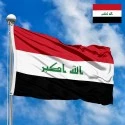
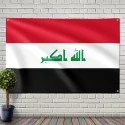
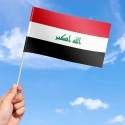
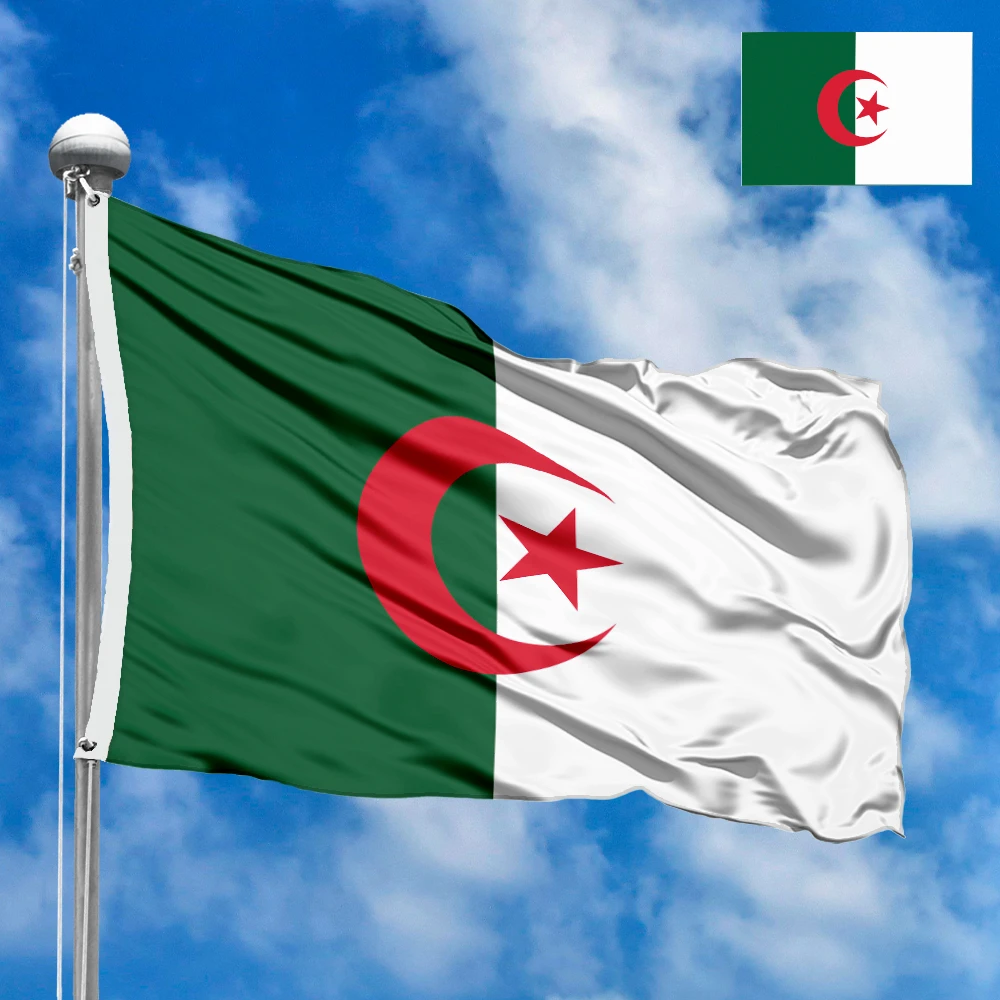
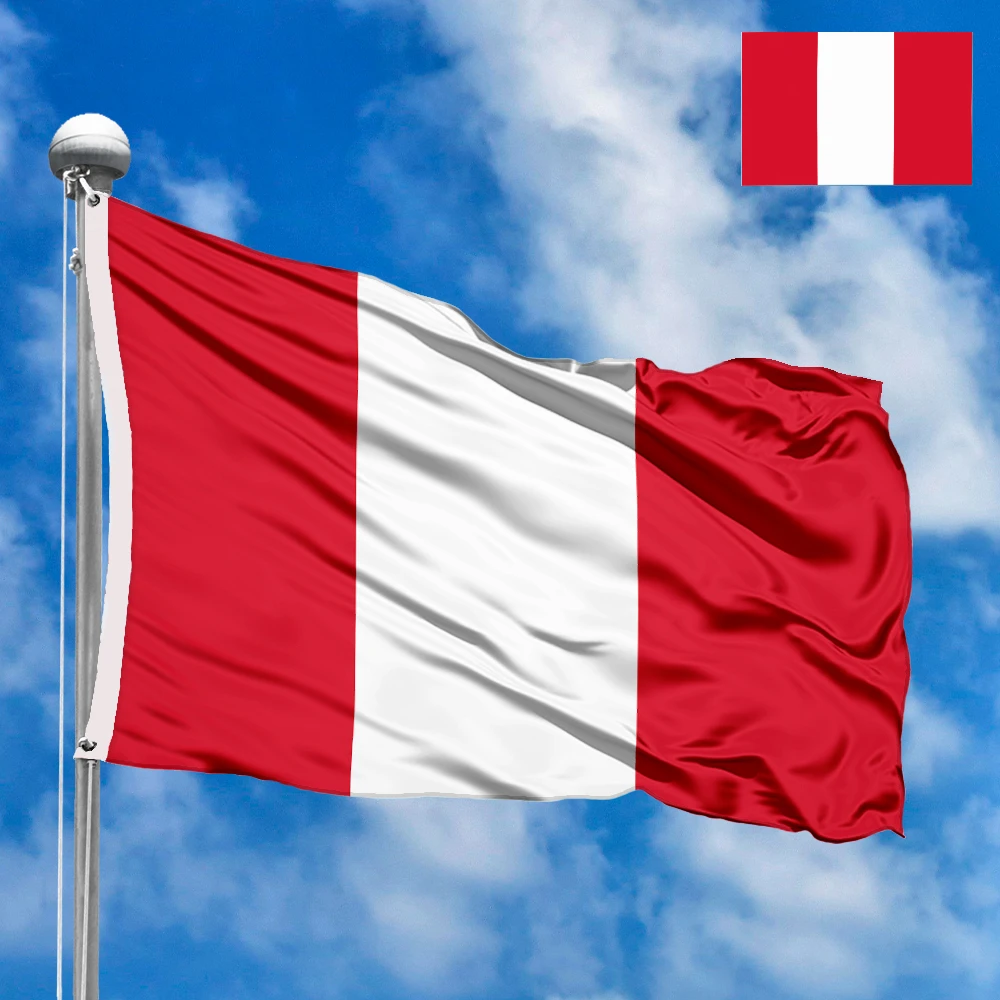





 Waving flag
Waving flag
 Sizes:
Sizes:
 Round flag
Round flag
 Sizes:
Sizes:
 Rectangular flag 2:3
Rectangular flag 2:3
 Sizes:
Sizes: